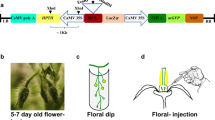Abstract
Transgenic cotton (Gossypium hirsutum L.) plants of a Texas cultivar CUBQHRPIS were obtained using Agrobacterium-mediated transformation coupled with the use of shoot-apex explants. After inoculation with A. tumefaciens strain LBA 4404 containing the pBI121 plasmid, regeneration of primary plants was carried out in a medium containing kanamycin (100 mg l-1). Progeny obtained by selfing were germinated in the greenhouse and selected for expression of the T-DNA marker gene encoding neomycin phospho-transferase II (NPTII) by painting kanamycin (2%) on the leaves. Plants that survived the leaf painting were analyzed by DNA blots. Evidence for integration of the transgene (GUS) was observed in two successive generations from the regenerants (T0). The transformed plants appeared to have more than one copy of the T-DNA.
Similar content being viewed by others
Author information
Authors and Affiliations
Additional information
Received: 1 June 1998 / Accepted: 28 July 1998
Rights and permissions
About this article
Cite this article
Zapata, C., Park, S., El-Zik, K. et al. Transformation of a Texas cotton cultivar by using Agrobacterium and the shoot apex. Theor Appl Genet 98, 252–256 (1999). https://doi.org/10.1007/s001220051065
Issue Date:
DOI: https://doi.org/10.1007/s001220051065




